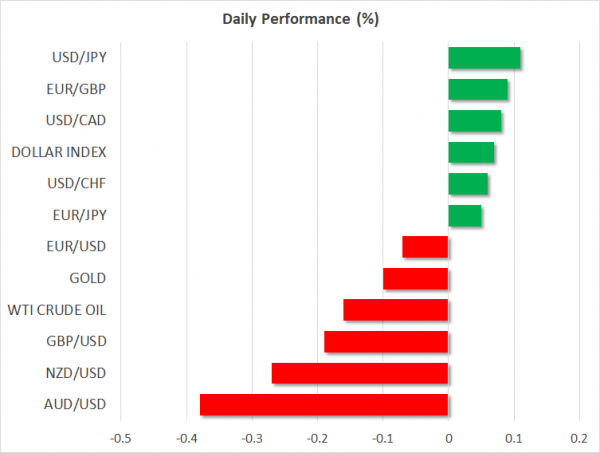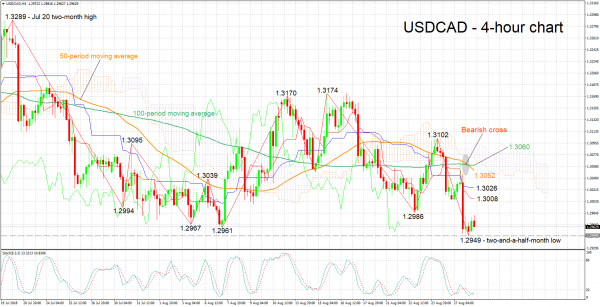Here are the latest developments in global markets:
FOREX: The dollar index was up on Tuesday, albeit by less than 0.1%, attempting to recover some of the losses it recorded yesterday as investors scaled back safe-haven bets on the currency, following headlines of a US-Mexico trade agreement. The euro capitalized on the dollar’s softness, advancing across the board on Monday, and reaching a fresh one-year high against the battered British pound. Meanwhile, the loonie climbed somewhat on the optimistic NAFTA headlines, touching a ten-week high against the dollar.
STOCKS: US markets enjoyed another day of robust gains, with the S&P 500 (+0.77%) and the Nasdaq Composite (+0.91%) both closing at new record highs for a second session in a row, propelled higher by news the US and Mexico reached a trade deal. The Dow Jones surged by 1.01% as well, edging closer to its own all-time peak. Meanwhile, futures tracking the S&P, Dow, and Nasdaq 100 are all flashing green, pointing to a marginally higher open today as well. Asian markets took their cue from their US counterparts on Tuesday, though the magnitude of the gains was modest. Japan’s Nikkei 225 (+0.06%) and Topix (+0.16%) barely advanced, as did the Hang Seng in Hong Kong (+0.09%). In Europe, all the major indices were set to open higher today, according to futures.
COMMODITIES: Oil prices are marginally lower on Tuesday, giving back some of the gains they posted in the previous session. WTI was down by 0.17% at $68.77 per barrel, while Brent was practically flat at $76.25 a barrel. Although the precious liquid benefited somewhat yesterday on signals trade tensions are subsiding, news that OPEC compliance with its output-cut deal is slipping kept a lid on any major gains. While OPEC compliance was at 109%, meaning members cut production by 9% more than agreed, that still represents a decline from last month’s 120% – implying production is rising. In precious metals, gold was down by 0.10% at $1,211 per troy ounce on Tuesday. The dollar-denominated yellow metal inched higher yesterday despite the risk-on sentiment, buoyed by a weaker greenback.
Major movers: US-Mexico trade deal boosts risk appetite, weighs on dollar
The US and Mexico reached an agreement on trade yesterday that is expected to replace NAFTA, though crucially, this deal does not include Canada yet; the Mexican peso advanced considerably on the news though it later gave back some of those gains. Both sides said they would welcome Canada joining in as well, but hinted that if the nation does not, then they may proceed regardless – raising pressure even further on Canadian officials. As for the details of the new accord, it requires 75% of auto content to be made in NAFTA countries, from 62.5% previously. Moreover, it calls for 40-45% of auto content to be produced by workers earning a minimum of $16 an hour, which is likely to bode well with workers in manufacturing-heavy US states ahead of the midterm elections.
The headlines likely sent the message that a full-blown “trade war” may indeed be avoided, and that the endgame is still the US striking new deals with its partners, thereby boosting risk appetite across markets. Stocks got a lift, with the S&P 500 and the Nasdaq Composite breaking new all-time highs, while safe-havens like the Japanese yen retreated. The dollar – which had also been acting as a haven asset in recent months – tumbled as well.
Meanwhile, although the loonie surged, the magnitude of its gains was relatively modest – smaller than one would have expected on concrete signs that NAFTA may be resolved soon. This suggests investors likely took the news with a grain of salt, as there is still some uncertainty involved with whether Canada will join the deal immediately, or perhaps opt to negotiate better terms beforehand. In this respect, Canada’s foreign minister Chrystia Freeland will head to Washington today for talks, and any remarks hinting at her country’s intentions could provide short-term direction to the loonie.
Apart from NAFTA, news flow was relatively light on Monday and during the Asian session Tuesday. The euro was once again the main beneficiary of the dollar’s underperformance, with euro/dollar currently trading just a few pips below the 1.1700 zone. The euro’s gains were more pronounced versus the battered British pound, though. Euro/sterling touched a fresh one year high earlier today, currently hovering near the 0.9070 territory and looking set to post the fifth day of advances in a row.
Day ahead: US consumer confidence and housing data due
The economic calendar is relatively light on Tuesday, featuring consumer confidence and housing data out of the US.
Data on lending and money supply for July will be released out of the European Central Bank at 0800 GMT.
The Conference Board’s consumer confidence index for August will be made public at 1400 GMT. The gauge is anticipated to weaken a bit after rising in July on the back of consumers’ optimism about the jobs market. One hour earlier, June’s CaseShiller indices, gauging US house prices, will be hitting the markets.
After yesterday’s NAFTA deal between Mexico and the US, the attention now perhaps turns to Canada: will it consent to new terms to preserve the trilateral trade agreement or will it enter into long discussions, pushing to keep the terms that it deems are instrumental for its interests?
In terms of policymakers’ appearances, ECB chief economist Peter Praet will be participating in a panel discussion on “monetary and macroprudential interactions” at 1100 GMT.
In energy markets, weekly API data on US crude stocks are due at 2030 GMT.
Technical Analysis: USDCAD bearish bias as it touches 2½-month low though stochastics give positive signal in very short-term
USDCAD hit a two-and-a-half-month low of 1.2949 earlier on Tuesday. The short-term bias is titled to the downside as indicated by the negatively-aligned Tenkan- and Kijun-sen lines. Still, the stochastics are giving a bullish signal in the very short-term as the %K line has moved above the slow %D one.
If Canada is seen as getting closer to a NAFTA deal then the loonie may come under buying interest, pushing USDCAD lower. Support to a declining pair may occur around today’s low of 1.2949, with steeper losses bringing into scope the 1.29 round figure.
On the other hand, if the US and Canada are seen as drifting away on the NAFTA front, then USDCAD is likely to head higher. Resistance to a rising pair may come around the current levels of the Tenkan- and Kijun-sen lines at 1.3008 and 1.3026, including the 1.30 handle. Further above, the region around the current level of the 50-period moving average at 1.3052 would be eyed.

















